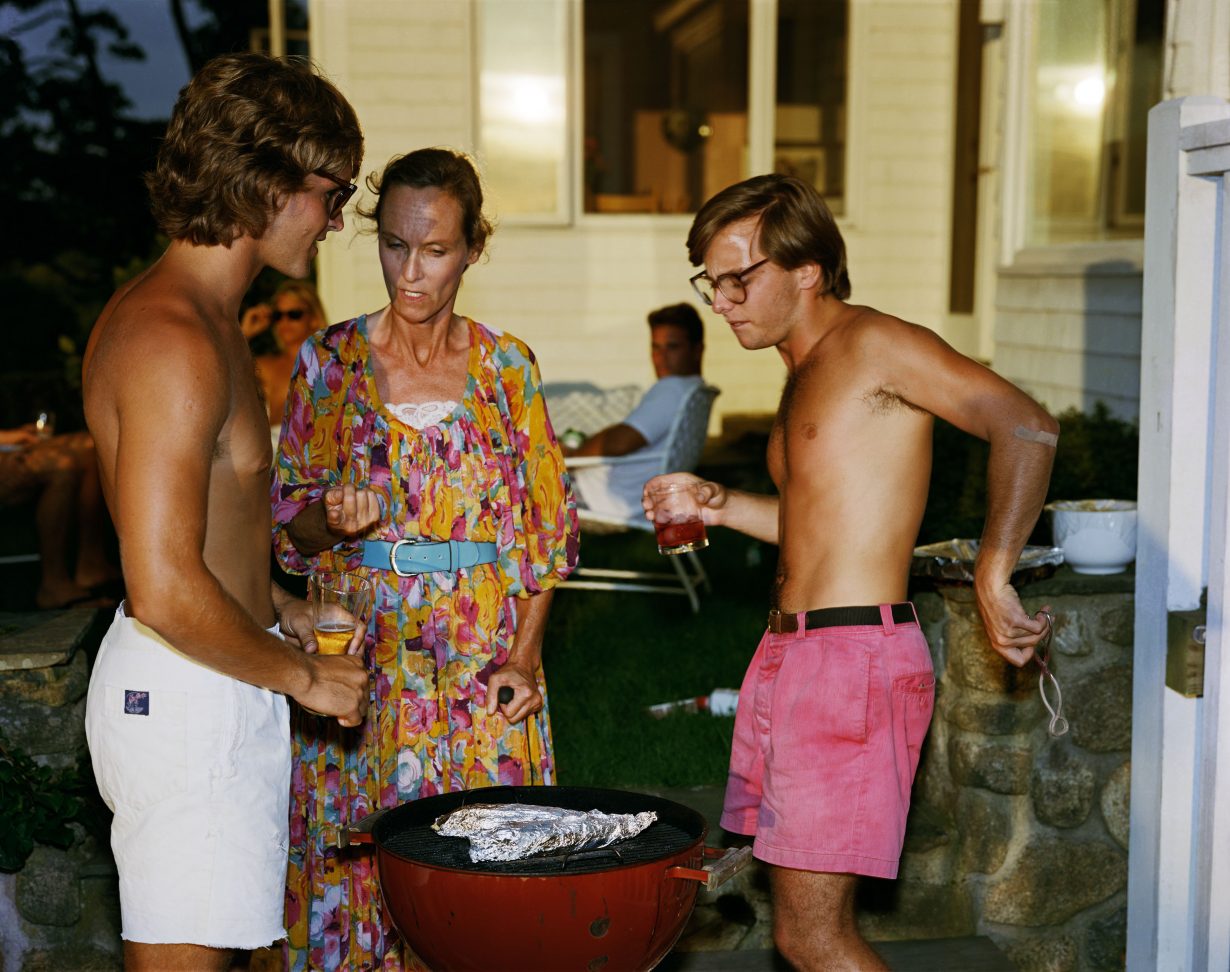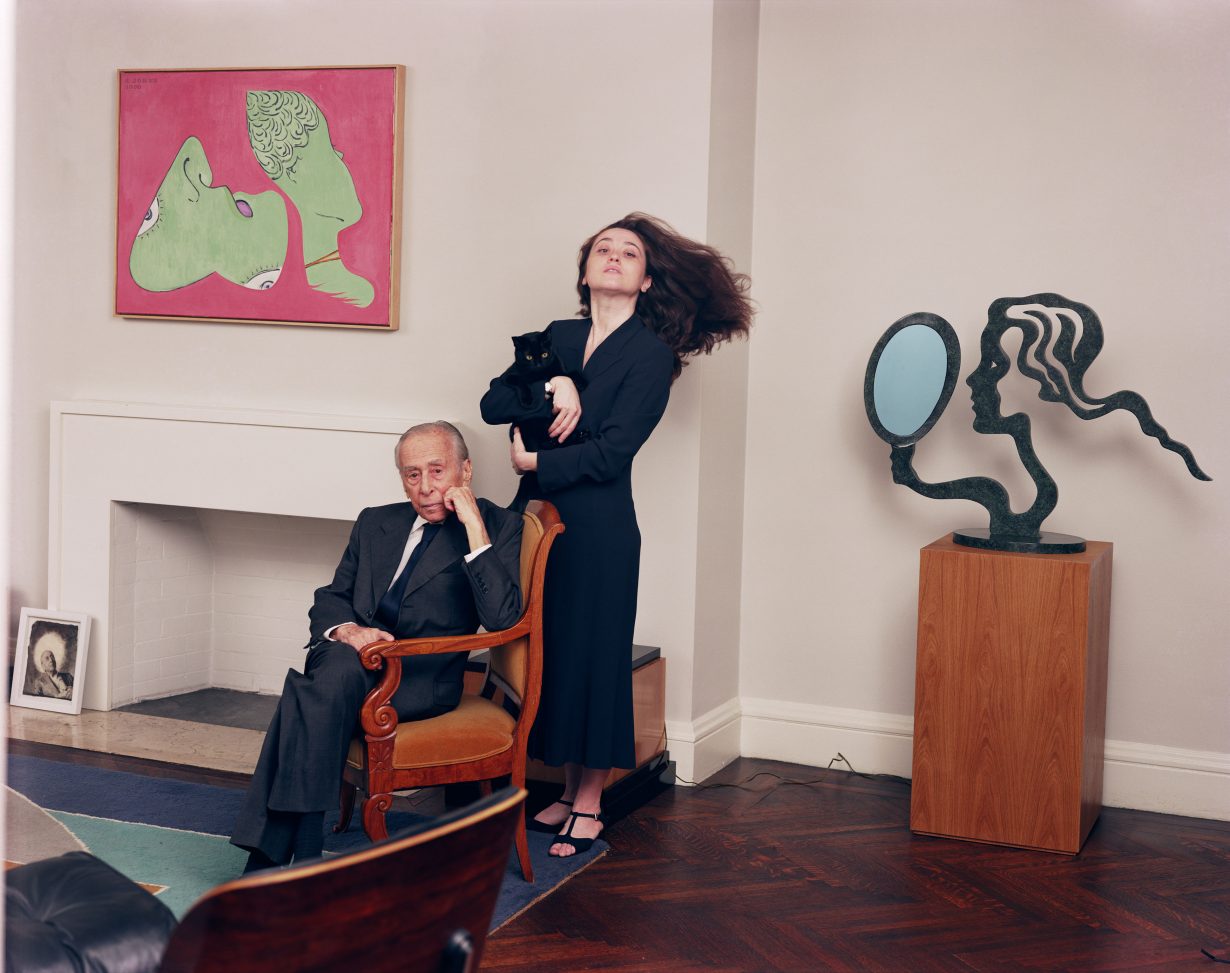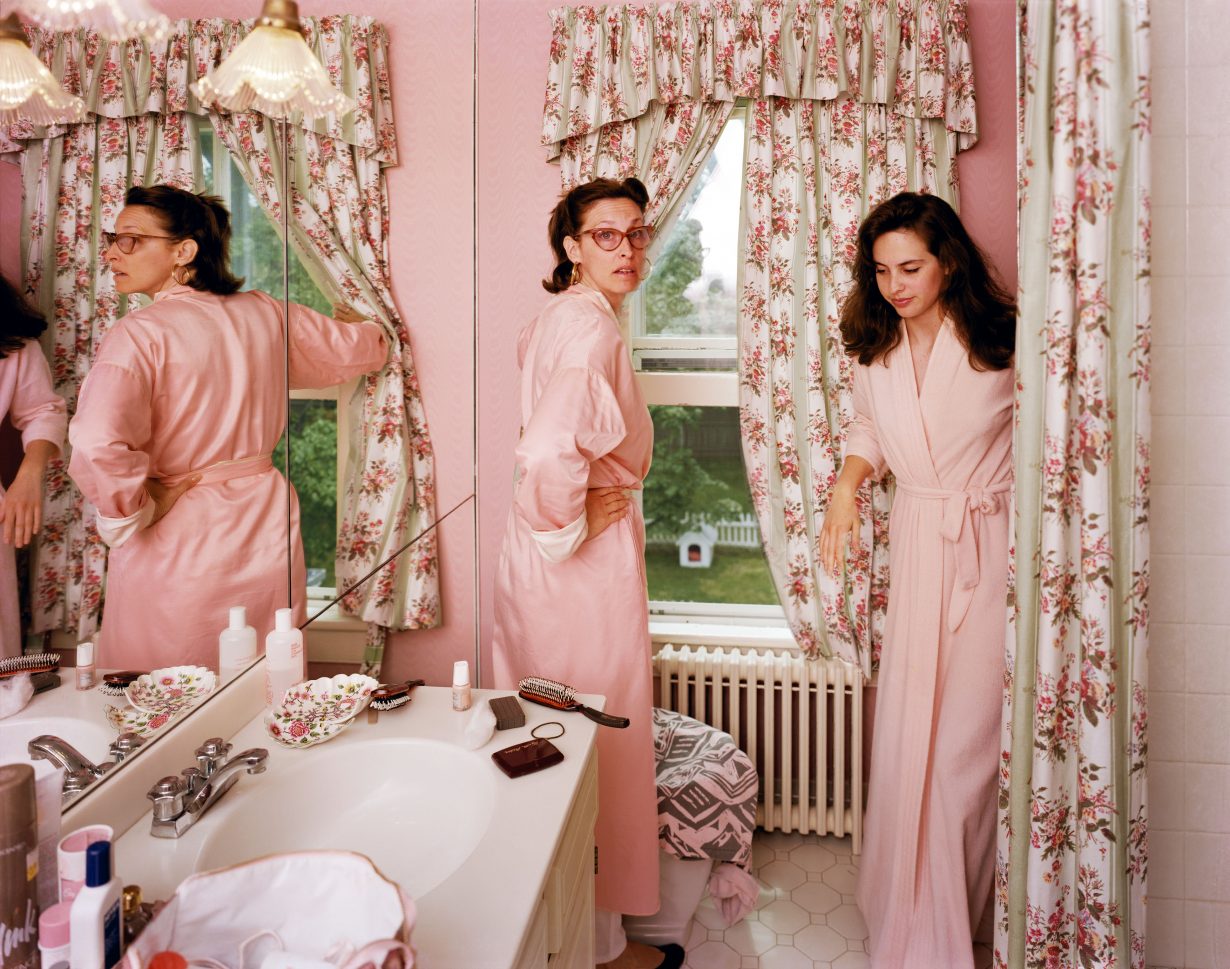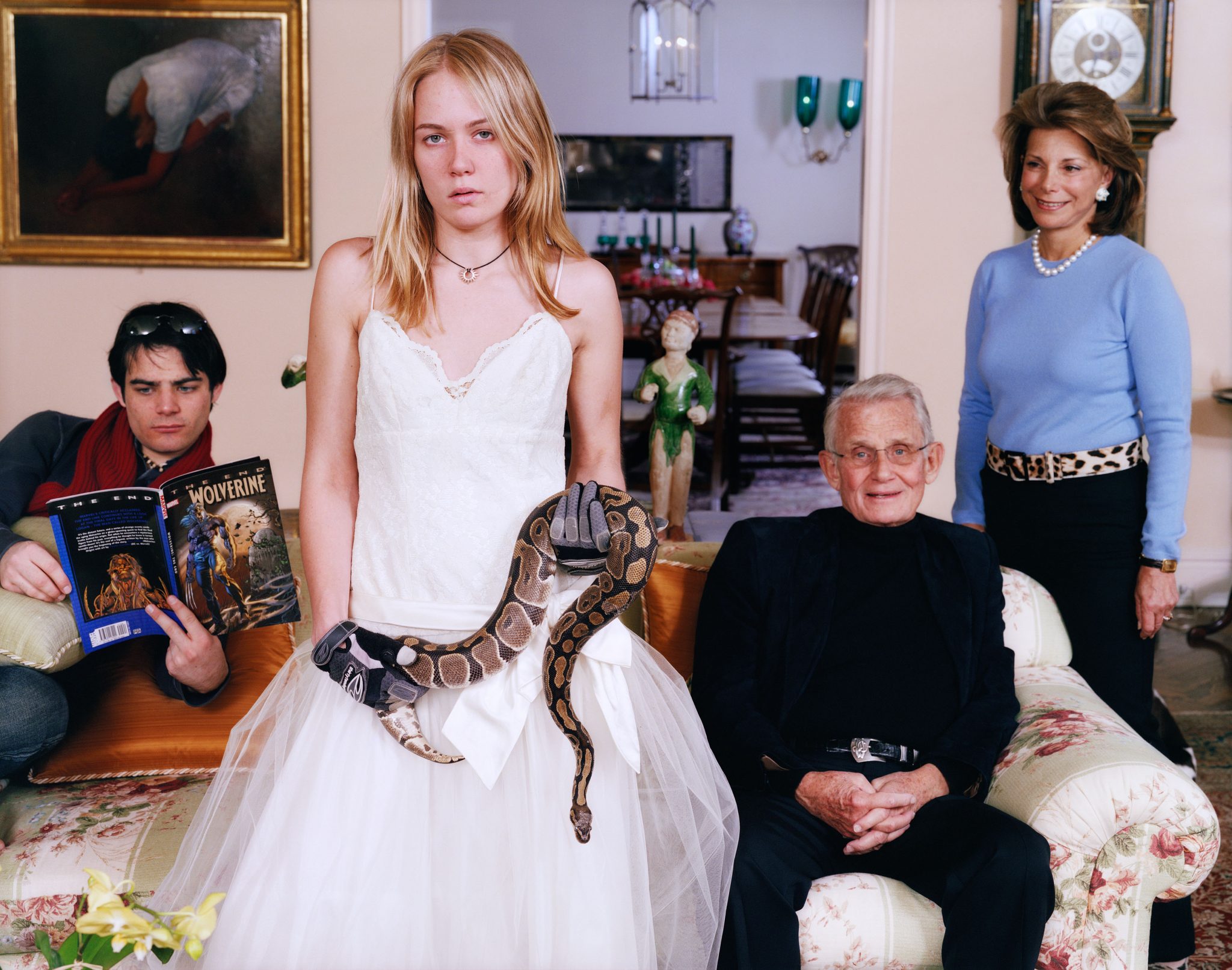The popular appeal of the photographer’s intimate portraits of the upper classes reveals the seductive fallacies of wealth
American photographer Tina Barney is known for her portraits of the rarefied world she grew up in. But in Family Ties, Barney’s first European retrospective at the Jeu de Paume in Paris, the clearest articulation of her stated intentions isn’t a photograph at all. In a Super 8 film (The Library, 1983) projected onto the exhibition’s exterior, a simple scene plays out in black and white. In a living room, white teenage boys watch a baseball game on a chintz floral sofa. Back issues of Vogue lie on the coffee table by their feet; a father gets on with some paperwork in the background. Another boy enters in tennis whites; they all chat; a phone rings. The scene is cozy, almost eerily so. Opening Family Ties with this intimate early film of her own family, in which bright white light obscures what lies beyond, suggests something from the show’s outset: the weight with which a word like ‘leisure’ actually exists because of what it presumably excludes. Barney is indeed a ‘photographer of the interior’, as director of Jeu de Paume Quentin Bajac writes in Family Ties’ catalogue. But for the photographer’s own part, she has said she is magnetised rather by the ‘repetition of traditions and rituals’, and ‘the idea that families, no matter where they come from, kind of do the same thing.’
Do they? Though her subjects of enquiry have spanned Old World elites (Europeans, 1996-2004) as well as spheres of performance and theatre (Players, 1988-2010), Barney is most widely recognised for her large-format photographs of her own blue-blooded, East Coast milieu, of which plenty are on display here in Paris. The impact of the photographs is in their sense of envelopment: in their sheer scale, her 48-by-60-inch prints – a consistent format for Barney – allow us to feel we are inside the homes and gardens of the rich. Even among the rituals of birthdays, weddings and Christmases they enact, the pleasure of witnessing Barney’s families do what they do is inseparable from the seductive, luxuriant environments in which they do it.

A descendant of the Lehman brothers who began taking photographs in the 1970s, Barney was one of the first photographers to present her colour photographs on such a grand scale, and in doing so aims to channel the Old Master works she grew up around (thanks to her art collector family). In these scenes, the eye springs from detail to detail and it can feel impossible to know where to look first. Barney’s scenes are rife with affluent material culture and made for the magpie-eyed: a potpourri of textures, fabrics, colours, china and furniture. Speaking about her family Super 8s, Barney says in an interview in the show’s catalogue: ‘There doesn’t have to be a story. I just love the way this looks.’ But the photographer has expressed frustration that her work has been interpreted as merely being about extremely wealthy people. On the first room’s panel: ‘People…think of the upper class […] which always disappoints me. What the photographs are about is family, the intersection of people who come from the same family, usually inside their own home.’ Such quotes become a refrain – the photographer’s throughline and also her defence – in the exhibition’s labels.
But even when the portraits don’t contain especial grandeur in an overtly material sense, they succeed at evoking the gentle, carefree chaos of the truly privileged. The oversized, multigenerational group reading sections of the paper in the kitchen of Sunday New York Times (1982) contains very little that could be seen as formally staged in any deliberate fashion, while the décor is haphazard. Yet the scene it brings to life speaks to the comfortable intergenerational relationships within families for whom social mobility took place generations back, where grandparents, parents and children are able to each feel at ease within the same circles of wealth, education and privilege. In that photograph, only the father at the head of the table holds still among the chaos, apparently on Barney’s shouted instruction. Such half-controlled, half-natural moments are where her crowded compositions source their power. Her methodology to achieve that is somewhat counterintuitive: she has long used her view camera with great speed, quickly inserting and extracting the sheet film, to give a sense of immediacy and randomness to her otherwise carefully staged, often artificially lit mise-en-scenes.

If Barney deflects from the wealth of her subjects in how she speaks about her work, she nevertheless has maintained, through her work for fashion campaigns and magazine editorials, a longstanding relationship with an industry premised upon the conspicuous display and consumption of luxury goods. Though Family Ties acknowledges how Barney parlayed her artmaking into this world, such commissions are displayed at the Jeu de Paume in the mix of the personal work without being labelled as such. In-situ, these works vary in terms of the dynamism they manage to maintain. Two Sisters (2019), which sits among Barney’s shots of her own family in the show, is a styled fashion shoot for American Vogue, made stiffly apparent due to the spacing of the girls (perfect for a double page spread), and the recognisably-Miu Miu dresses. Mr and Mrs Leo Castelli (1998), for W, is less identifiable as a magazine assignment. The portrait of the famed Italian-American art dealer together with his much younger third wife, Barbara Bertozzi, fizzes with their confounding of the unspoken assumption of the power dynamics between them. Whether or not we know anything about the artworld gossip that circulated this particular age-gap romance at the time, Barney’s decision to have Bertozzi’s hair swish as the only movement in frame, as she stands tall above her husband, signals a message of her quiet dominance.
Even without such assignments for fashion magazines, Barney’s work has sustained a longstanding appeal to the fashion literate. She has also found a new generation of fans among younger audiences. Observing stylish teenage girls looking at Sofia Coppola-coded photographs like Jill And Polly in the Bathroom (1987) at the Jeu De Paume, I thought of the current rise of the ‘Old Money aesthetic’ among the wardrobes of young people: specifically one that evokes the East Coast elites that Barney documented. Described as ‘a fantastical imagining of what rich people wear in private’ by Vogue, the Business of Fashion reported that the term was searched more than 74,000 times per month in 2023. As the preppy styles of Barney’s milieu and the like percolate into everyday wardrobes and homes, then, it is perhaps a happy accident for Family Ties that being rich is, apparently, ‘cool again’.

The Tulips, from 2001, is one such portent of the particular, subtle modulations of wish fulfilment that mark our own era. Lifted from Barney’s otherwise static portraits of Europeans, an open door to the right of frame and other domestic details (iron, towel) allows us a heightened sense of being in the room with the stylish young woman arranging flowers. But in the gallery space in 2024, the portrait is also an entrance into certain whimsical channels of ‘good taste’, and how our aspirations tend to interface with the images we consume online today. For Gen Zs and millennials without ongoing familial support or an upcoming inheritance, for whom home ownership is increasingly out of reach, signifiers of wealth have been replaced instead by more achievable simulations: some might seek out ‘old money’ clothing, others arrange cut-price supermarket tulips from Tescos for their rented apartments. There is a sense to such images that feels less like being given access to the opulent homes of the old-world elite and more a reflection of the growing ambiguity when it comes to the wealth disparity among young people today.

Of course, taken in its totality at the Jeu De Paume, the aspirational quality of Barney’s work can be located, as it always has been, in its window onto preppy teenagers, European Aristocrats or even Hollywood celebrities at home. Such channels of desire are nothing new. But Barney’s signature melding of the carefully-directed and spontaneous, the public and private, and the commercial and personal are up-to-the-minute in another, less-discussed way. Barney’s retrospective is running during a moment, to list some examples, in which savvy estate agents like The Modern House publish articles peeking inside the homes of the new wealthy class of homeowning creatives, a new interiors magazine seems to be founded every few months, and artists and photographers keep the problematic commercial sources supplementing their income an unspoken secret. More than simply the nostalgic documents of Reaganite America they are usually framed as, Barney’s practice of portraiture resonates with a present moment where many of us curate an aspirational version of our own lives (in day-to-day decisions and for social media) and claim – perhaps even believe – we are simply being authentic. Whether she means it or not, both Barney’s work and the naivety with which she speaks about it reveals ties between industries of taste, lifestyle imagery and art photography so hopelessly entangled that they are, like the codes of the upper-class, designed to be whispered.
Claire Marie Healy is a writer and editor covering film, art, fashion and the internet. She is the author of Girlhood (Tate Publishing), 2023
